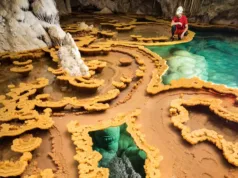Puy de Dôme is a dormant volcano located in the Massif Central region of France, part of the Chaîne des Puys volcanic chain, which is a UNESCO World Heritage Site. Rising to an elevation of 1,465 meters (4,806 feet), it is one of the most iconic natural landmarks in France, known for its distinctive rounded shape and the panoramic views it offers of the surrounding Auvergne region.
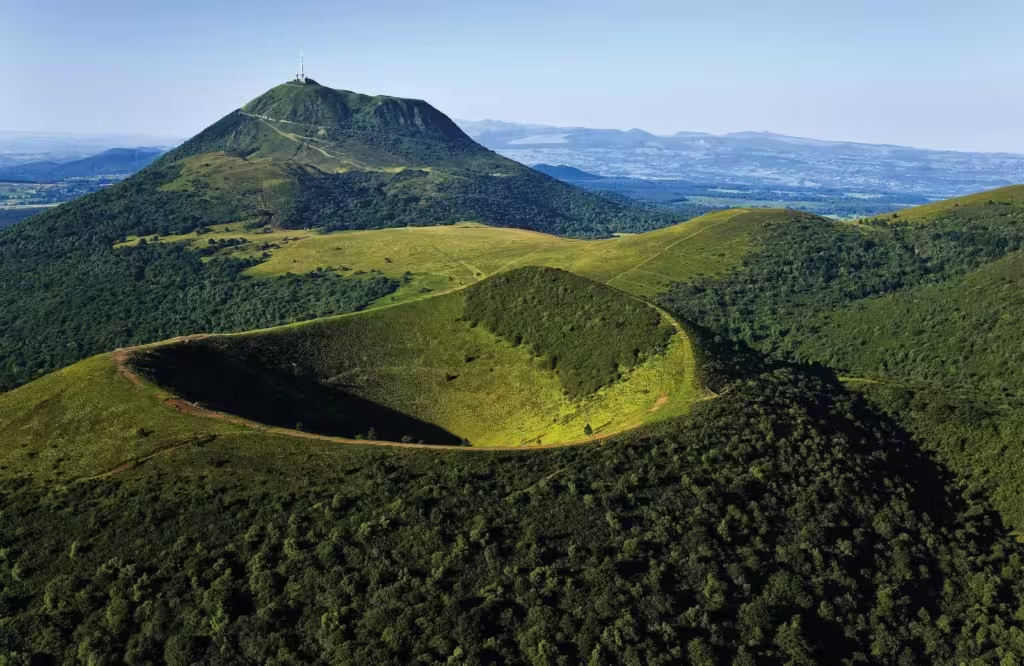
Importance and Uniqueness
Puy de Dôme holds a special place in both the natural and cultural heritage of France and Europe. As a geological site, it provides an exceptional example of a volcanic dome and is a key site for understanding volcanic activity and geological processes in Europe. The Chaîne des Puys, of which it is a part, is the youngest volcanic chain in France and represents a rare geological formation known as a “tectonic hotspot.”
Its importance extends beyond geology; Puy de Dôme is a popular destination for tourists, hikers, and paragliders, offering numerous trails and a unique opportunity to explore volcanic landscapes. It also has historical significance, with ancient Roman remains, such as the Temple of Mercury, located at its summit. The site’s combination of natural beauty, scientific interest, and cultural history makes it a unique and invaluable location in both France and Europe.
Geographical and Geological Features of Puy de Dôme
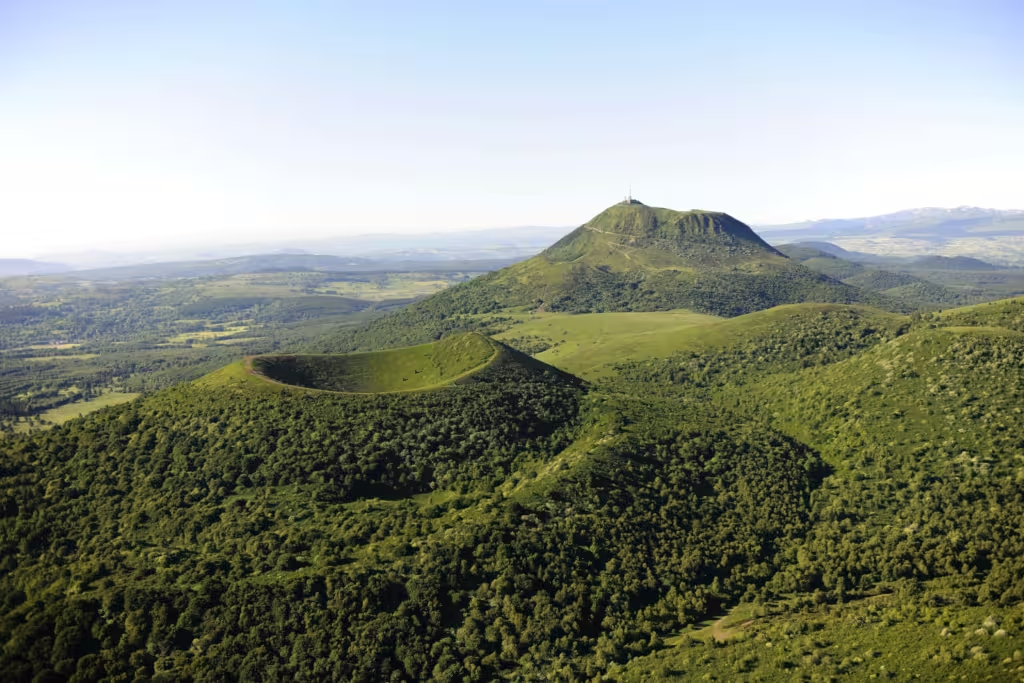
Geographical Location: Puy de Dôme is situated in the Auvergne region of central France, near the city of Clermont-Ferrand. It is part of the Chaîne des Puys, a 40-kilometer-long chain of more than 80 volcanic craters, domes, and lava flows that runs north to south through the Massif Central. Puy de Dôme is the tallest of these volcanic formations, dominating the landscape with its distinct, rounded summit and offering panoramic views over the surrounding area.
Geological Characteristics: Puy de Dôme is classified as a “lava dome” or “volcanic dome,” which is formed by the slow extrusion of viscous lava from a volcanic vent. Unlike many other types of volcanoes, Puy de Dôme did not experience explosive eruptions but rather a steady outpouring of thick, silica-rich lava that built up to create its dome-like shape.
- Age and Formation: Puy de Dôme was formed approximately 10,000 to 15,000 years ago during the Holocene epoch, making it a relatively young volcano in geological terms. Its formation was the result of volcanic activity related to the African and European tectonic plates’ movements.
- Volcanic Structure: The volcano consists primarily of trachyte, a type of volcanic rock rich in feldspar and quartz. The high silica content of the lava led to its slow flow, contributing to the creation of the dome structure. The dome is surrounded by other volcanic features, including cinder cones and maars (volcanic craters formed by explosive interactions between magma and groundwater).
- Unique Geomorphology: The volcano’s steep slopes and rounded summit are covered with vegetation, which contrasts sharply with the bare volcanic rock seen in other parts of the Chaîne des Puys. The geomorphology of Puy de Dôme also includes deeply eroded gullies and ridges formed by water runoff, contributing to its distinctive appearance.
Environmental and Climatic Conditions: Puy de Dôme’s elevation creates a unique microclimate with colder temperatures and higher precipitation than the surrounding lowlands. The summit is often shrouded in clouds, and during winter, it can be covered with snow. These conditions support a range of plant species, including rare alpine flora that thrive in the nutrient-rich volcanic soils.
Seismic and Geological Significance: As part of the Chaîne des Puys, Puy de Dôme provides an invaluable insight into volcanic activity and tectonic processes in a continental setting. Although it is considered dormant, the entire region remains a subject of ongoing geological research to understand better the area’s volcanic history and potential future activity.
The combination of its prominent location, unique geological features, and the surrounding volcanic landscape makes Puy de Dôme a fascinating subject of study and a key natural landmark in France and Europe.
Geological Formation of Puy de Dôme

Origin as a Dormant Volcano:
Puy de Dôme is a prominent example of a volcanic dome, which forms from the slow extrusion of highly viscous lava. Unlike shield volcanoes, which have broad, gently sloping sides formed by fluid lava flows, or stratovolcanoes, which are characterized by explosive eruptions and layered lava and ash deposits, volcanic domes like Puy de Dôme develop from the relatively slow accumulation of lava that piles up near the vent.
Formation Process:
- Volcanic Activity: The formation of Puy de Dôme began during the Holocene epoch, roughly 10,000 to 15,000 years ago. It is a part of the Chaîne des Puys, a volcanic chain that developed due to tectonic activity associated with the African and European plates. This volcanic chain is situated in the Massif Central region of France.
- Lava Composition: The lava that erupted to form Puy de Dôme is primarily trachyte, a type of lava that is rich in silica (about 60-65% SiO₂) and has a high viscosity. This high viscosity causes the lava to flow slowly and build up around the volcanic vent rather than spreading out widely.
- Dome Formation: Over time, the accumulation of this viscous lava created the dome-shaped structure of Puy de Dôme. The lava’s slow movement allowed it to build up into a steep, rounded shape, characteristic of volcanic domes.
- Erosion and Surface Features: The surface of Puy de Dôme has been shaped by both volcanic processes and natural weathering. The dome’s steep slopes and rounded summit have been subject to erosion from wind and water, which has created features such as deep gullies and ridges. Vegetation and soil have developed on the dome’s slopes, contributing to its distinctive appearance compared to other volcanic formations.
Part of the Chaîne des Puys:
- Volcanic Chain: Puy de Dôme is a key component of the Chaîne des Puys, a volcanic chain extending approximately 40 kilometers from north to south in the Massif Central. The Chaîne des Puys is characterized by a series of volcanic features including craters, domes, cinder cones, and maars.
- Tectonic Setting: The Chaîne des Puys formed due to the tectonic activity associated with the movement of the African and European plates. The region experiences hotspot volcanism, where a plume of hot material from the Earth’s mantle rises to create volcanic activity.
- Significance: The Chaîne des Puys is notable for its well-preserved volcanic features and provides a valuable geological record of volcanic activity in continental settings. Puy de Dôme, as the tallest and most prominent dome in the chain, plays a significant role in the understanding of volcanic processes and the geological history of the region.
Dormancy:
Although Puy de Dôme is considered dormant, it is not extinct. The term “dormant” indicates that the volcano has not erupted in recent history but could potentially become active again in the future. Its current state is characterized by a lack of recent volcanic activity, with the last eruptions occurring thousands of years ago.
Overall, Puy de Dôme’s formation as a dormant volcanic dome and its role in the Chaîne des Puys highlight its importance in understanding volcanic processes and the geological evolution of the Massif Central region.
Historical Significance of Puy de Dôme
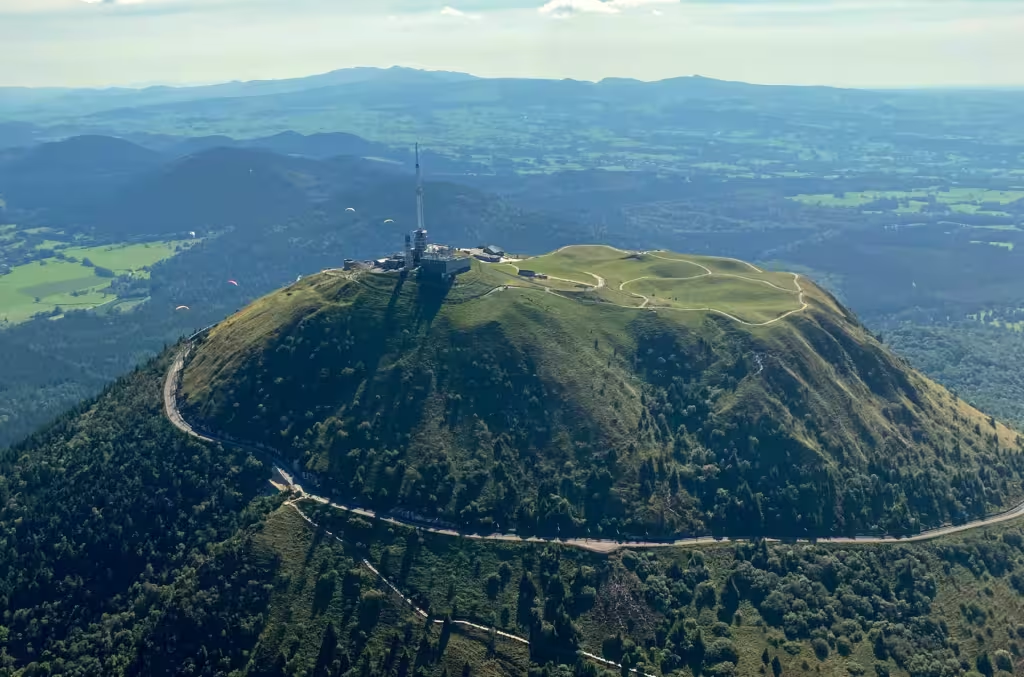
Ancient History:
- Gallic and Roman Sites: Puy de Dôme has been a site of historical and cultural significance since ancient times. During the Gallic period, the volcano was considered a sacred place. The Romans later recognized its importance, and one of the most notable remnants from this era is the Temple of Mercury, which was built at the summit of Puy de Dôme. The temple was dedicated to Mercury, the Roman god of commerce and travel, and was an important religious and ceremonial site. Archaeological excavations have revealed ruins of this temple and other Roman structures, indicating the site’s prominence in Roman religious practices.
- Celtic Significance: Before the Roman period, the site was associated with Celtic tribes, who revered natural sites such as Puy de Dôme. The Celts often considered high places like mountains and volcanic peaks to be sacred, and Puy de Dôme’s prominence in the landscape would have made it a significant location for rituals and ceremonies.
Role in Local Culture and Folklore:
- Cultural Significance: In local culture, Puy de Dôme has been a symbol of the region’s natural beauty and spiritual heritage. Its imposing presence and unique shape have inspired various myths and legends. For example, the volcano is often featured in local folklore as a mystical place where gods and spirits reside. Its prominent position in the landscape made it a natural focal point for local stories and traditions.
- Folklore: The volcano’s distinctive shape and volcanic activity have contributed to various myths and legends in the Auvergne region. In some tales, the mountain is portrayed as a giant or a sleeping deity, reflecting its ancient sacred significance.
Modern Historical Events Linked to Puy de Dôme:
- Scientific Research: In the 19th and 20th centuries, Puy de Dôme became a significant site for scientific research. In particular, the volcano was studied for its geological features and volcanic history. Notably, the Puy de Dôme Observatory, established in the 19th century, played a crucial role in advancing scientific knowledge about volcanic activity and the region’s geology.
- Cultural and Sporting Events: In more recent times, Puy de Dôme has been the site of various cultural and sporting events. One of the most famous is the Clermont-Ferrand Cycling Race, which includes a challenging ascent of the volcano as part of its route. The climb is celebrated by cycling enthusiasts and showcases the mountain’s ongoing role in local and national events.
- Tourism and Conservation: In the late 20th and early 21st centuries, Puy de Dôme has become a popular tourist destination, attracting visitors for its natural beauty, hiking trails, and historical sites. Efforts have been made to preserve and promote the site’s historical and geological significance, including its designation as a UNESCO World Heritage Site as part of the Chaîne des Puys.
Overall, Puy de Dôme’s historical significance spans from ancient religious practices to modern scientific research and tourism, reflecting its importance in the cultural and scientific history of France and Europe.
Tourism and Activities at Puy de Dôme
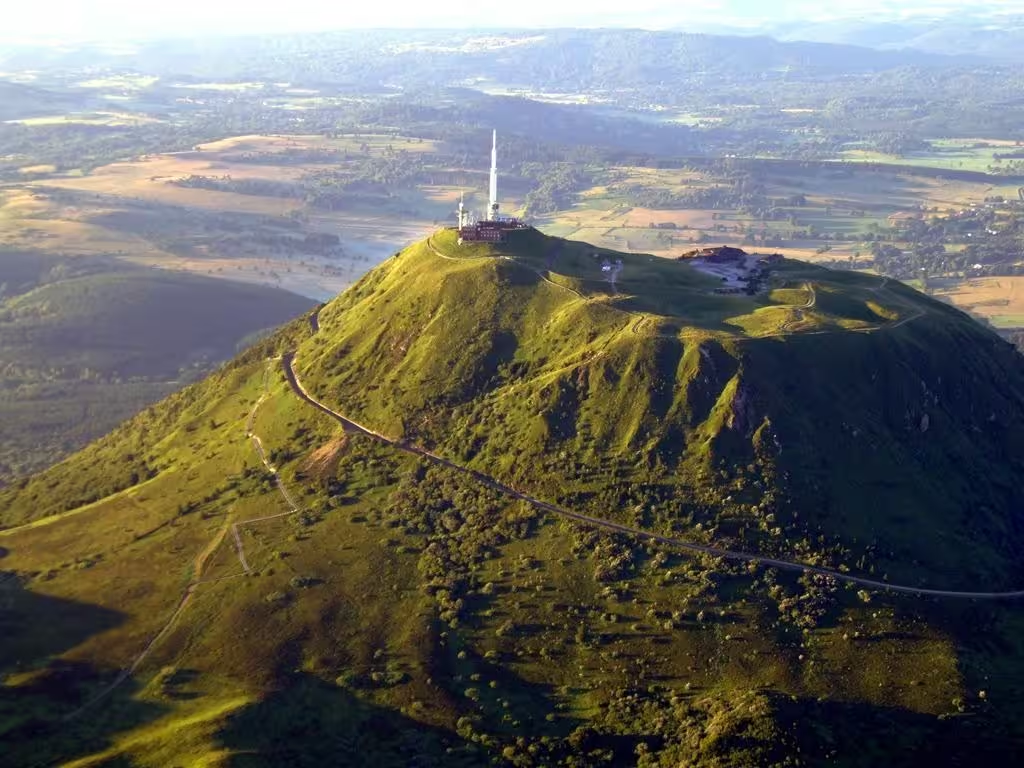
Popular Tourist Activities:
- Hiking: One of the most popular activities at Puy de Dôme is hiking. Several well-maintained trails lead to the summit, offering spectacular views of the surrounding landscape. The trails vary in difficulty, catering to both casual walkers and experienced hikers. The ascent provides a chance to experience the diverse flora and fauna of the region, as well as the geological features of the volcanic landscape.
- Paragliding: For those seeking an adrenaline rush, paragliding from Puy de Dôme offers a unique perspective of the volcanic terrain. The summit provides an excellent launch point for paragliding enthusiasts, with breathtaking aerial views of the Chaîne des Puys and the Auvergne region.
- Railway Tram: The Panoramique des Dômes is a cogwheel railway tram that transports visitors from the base of Puy de Dôme to the summit. This scenic ride offers panoramic views of the volcanic chain and the surrounding countryside, making it a popular choice for those who prefer a more leisurely ascent.
Visitor Facilities:
- Observation Deck: At the summit of Puy de Dôme, there is an observation deck that provides 360-degree views of the surrounding area. On clear days, visitors can see as far as the city of Clermont-Ferrand and the distant mountain ranges of the Auvergne.
- Restaurant: A restaurant located near the summit offers visitors a place to relax and enjoy a meal with stunning views. The menu typically features regional cuisine, allowing guests to experience local flavors while taking in the scenery.
- Visitor Center: The visitor center at the base of Puy de Dôme provides information about the volcano’s geology, history, and ecology. It includes exhibits, interactive displays, and maps to help visitors understand the significance of the site and plan their visit.
Seasonal Considerations:
- Best Times to Visit: The best times to visit Puy de Dôme are during the spring (April to June) and autumn (September to October). During these periods, the weather is generally mild, and the trails are less crowded compared to the summer months. Spring offers blooming flowers and fresh greenery, while autumn provides colorful foliage and cooler temperatures.
- Weather Impacts: Weather can significantly impact the experience at Puy de Dôme. In summer, the weather is usually warm and sunny, making it ideal for hiking and outdoor activities. However, this is also the peak tourist season, so it can be crowded.In winter, snow and ice can make hiking trails slippery and challenging. However, the snow-capped landscape offers a picturesque setting for those who enjoy winter sports. The Panoramique des Dômes tram may also be affected by winter weather, so it’s important to check for operational status.In rainy or foggy weather, visibility from the observation deck and during paragliding may be reduced, affecting the overall experience. It’s a good idea to check weather forecasts before planning a visit and to be prepared for changing conditions.
Overall, Puy de Dôme offers a range of activities and facilities for visitors, making it a versatile destination for outdoor enthusiasts, nature lovers, and those interested in the region’s geological and cultural heritage.


























